

D-Wave Systems. D-Wave Systems, Inc. is a quantum computing company, based in Burnaby, British Columbia.

On May 11, 2011, D-Wave System announced D-Wave One, labeled "the world's first commercially available quantum computer," operating on a 128 qubit chip-set[1] using quantum annealing [2][3][4][5] to solve optimization problems. In May 2013 it was announced that a collaboration between NASA, Google and the Universities Space Research Association (USRA) launched a Quantum Artificial Intelligence Lab based on the D-Wave Two 512 qubit quantum computer that would be used for research into machine learning, among other fields of study.[6] The D-Wave One was built on early prototypes such as D-Wave's Orion Quantum Computer. Technology description[edit] D-Wave maintains a list of peer-reviewed technical publications on their website, authored by D-Wave scientists and by third party researchers.
History[edit] Orion prototype[edit] According to Dr. 2009 Google demonstration[edit]
Burnaby. Burnaby is a city in British Columbia, Canada, located immediately to the east of Vancouver.

It is the third-largest city in British Columbia by population, surpassed only by nearby Surrey and Vancouver. It was incorporated in 1892 and achieved City status in 1992, one hundred years after incorporation. It is the seat of the Greater Vancouver Regional District's government, the board of which calls itself Metro Vancouver.
History[edit] At incorporation, the municipality's citizens unanimously chose to name it after the legislator, speaker, Freemason and explorer Robert Burnaby, who had been private secretary to Colonel Richard Moody, the first land commissioner for the Colony of British Columbia, in the mid-19th century.[1] In 1859 Burnaby had surveyed the freshwater lake near what is now the city's geographical centre. Geography and land use[edit] Modern high-rises of central Burnaby overlooking Deer Lake Burnaby is home to many industrial and commercial firms. NP-complete. Although any given solution to an NP-complete problem can be verified quickly (in polynomial time), there is no known efficient way to locate a solution in the first place; indeed, the most notable characteristic of NP-complete problems is that no fast solution to them is known.
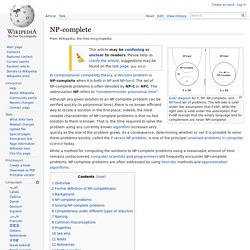
That is, the time required to solve the problem using any currently known algorithm increases very quickly as the size of the problem grows. As a consequence, determining whether or not it is possible to solve these problems quickly, called the P versus NP problem, is one of the principal unsolved problems in computer science today. NP (complexity)
In computational complexity theory, NP is one of the most fundamental complexity classes.

The abbreviation NP refers to "nondeterministic polynomial time. " Intuitively, NP is the set of all decision problems for which the instances where the answer is "yes" have efficiently verifiable proofs of the fact that the answer is indeed "yes". More precisely, these proofs have to be verifiable in polynomial time by a deterministic Turing machine. Time complexity. Non-deterministic Turing machine. In theoretical computer science, a Turing machine is a theoretical machine that is used in thought experiments to examine the abilities and limitations of computers.
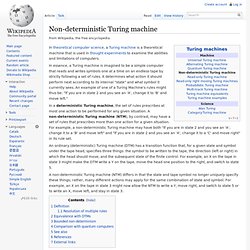
In essence, a Turing machine is imagined to be a simple computer that reads and writes symbols one at a time on an endless tape by strictly following a set of rules. It determines what action it should perform next according to its internal "state" and what symbol it currently sees. An example of one of a Turing Machine's rules might thus be: "If you are in state 2 and you see an 'A', change it to 'B' and move left. " In a deterministic Turing machine, the set of rules prescribes at most one action to be performed for any given situation. Decision problem. A decision problem has only two possible outputs, yes or no (or alternately 1 or 0) on any input.
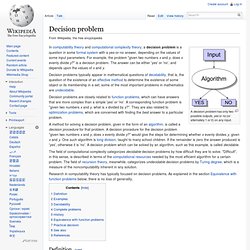
In computability theory and computational complexity theory, a decision problem is a question in some formal system with a yes-or-no answer, depending on the values of some input parameters. For example, the problem "given two numbers x and y, does x evenly divide y? " is a decision problem. The answer can be either 'yes' or 'no', and depends upon the values of x and y.
Decision problems are closely related to function problems, which can have answers that are more complex than a simple 'yes' or 'no'. Polynomial expression. The entities may be themselves expressions, not necessarily polynomial ones.

For instance, it is possible to use the de Moivre's identity for any integer n to express cos(nx) as a polynomial expression in (the entity) cos(x), as in cos(3x) = 4 cos(x)3 − 3 cos(x). Here it would be incorrect to call the right hand side a polynomial.The entities may be matrices; for instance the Cayley–Hamilton theorem applied to a matrix A equates a certain polynomial expression in A to the null matrix.The entries may be "somewhat unknown" quantities without being completely free variables. For instance, for any monic polynomial of degree n that has n roots, Viète's formulas express its coefficients as (symmetric) polynomial expressions in those roots. Polynomial. The graph of a polynomial function of degree 3 Etymology[edit] According to the Oxford English Dictionary, polynomial succeeded the term binomial, and was made simply by replacing the Latin root bi- with the Greek poly-, which comes from the Greek word for many.
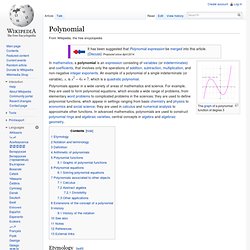
Indeterminate (variable) A polynomial in an indeterminate X is an expression of the form , where the ai are called the coefficients of the polynomial.
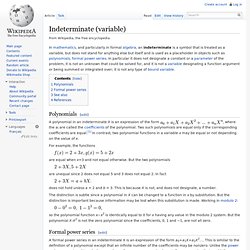
Two such polynomials are equal only if the corresponding coefficients are equal.[1] In contrast, two polynomial functions in a variable x may be equal or not depending on the value of x. For example, the functions are equal when x=3 and not equal otherwise. But the two polynomials are unequal since 2 does not equal 5 and 3 does not equal 2. Does not hold unless a = 2 and b = 3. 1401.7087v1. Protein folding. Protein before and after folding.
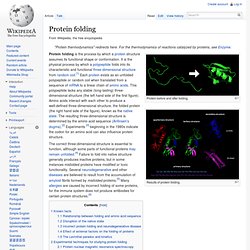
Results of protein folding. Protein folding is the process by which a protein structure assumes its functional shape or conformation. It is the physical process by which a polypeptide folds into its characteristic and functional three-dimensional structure from random coil.[1] Each protein exists as an unfolded polypeptide or random coil when translated from a sequence of mRNA to a linear chain of amino acids.